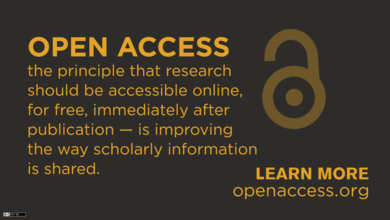
Open access is a complex issue which has numerous challenges for all those involved (Curry, 2012). This post will look at the advantages and disadvantages of open access in relation to academic journals. For an introduction to open access have a look at this great slideshare.
Providing open access to academic journals allows for innovation and growth in research, because research only works when we interchange ideas (Finch, 2012). Everyone should be able to access information that can further their understanding, especially research that has been publicly funded. Opening access to new and archived journals is also essential to bridge the gap in knowledge between developing and developed countries. Many journal subscriptions are too expensive for developing countries to access; open access would eliminate this barrier.
The following video sees open access as an integral part of maintaining democracy. Opening up journals and data allows for cross-disciplinary research, which is essential to answer our current global challenges.
Thus open access has the potential to increase the exposure and use of published research, facilitate the ability to develop topics discusses in previous literature, and enhance individuals’ education.
Unfortunately, ‘open’ does not mean ‘free’ – cost is often cited as the biggest disadvantage to open access. The content producer is often deterred by the cost of publishing an open access paper. However, Suber (2013) explains that only 6% of authors who publish in open access journals pay fees ‘out-of-pocket’. However, we must consider that it falls to institutions to pay these costs. The funds that would have been distributed to support research or purchase published work, are redirected to support the author’s publishing fees (Manista, 2012).
The distinction between green and gold open access must be made. The flow chart below outlines the process for both green and gold open access.
If we remove the up-front article processing charges in the ‘gold’ model, they are replaced by inflexible embargoes in the ‘green’ model. Allen (2015) suggests this will damage the financial viability of many scholarly journals and weaken the quality and integrity of the system, including the vital peer review process.
Concerns for quality and copyright have also been cited as disadvantages of open access. Copyright laws are outdated and have not kept pace with the evolving nature of the web or open access. If you are interested have a look at this editor’s article. The concern for quality comes mainly in the form of lack of peer review, or the profiteering from the ‘gold’ model of open access. The ‘gold’ model makes publishers money and it has been reported that some open access journals accept inferior quality work to receive the article processing fee (Shaw, 2013).
Allen, T. (2015) Scientific publishing policy should be based on facts, not politics, The Hill.
Curry, S. (2012) UK plan for open access to research is a golden opportunity, not a cost, The Guardian.
Finch, J.D. (2012) Accessibility, Sustainability, Excellence: How to Expand Access to Research Publications, Report of the Working Group on Expanding Access to Published Research Findings.
Manista, F. C. (2012) “Open Don ’t Mean Free”: A Reflection on the Potential Advantages and Disadvantages of Publishing Research via Open Access, Journal of Librarianship and Scholarly Communication, Vol. 1 (2).
Shaw, C. (2013) Hundreds of open access journals accept fake science paper, The Guardian.
Suber, P. (2013) Open access: six myths to put to rest, The Guardian.

Pingback: Topic 5: Reflection | HayleyMatthews
This is a great article with lots of information and simple explanations. Great post!
LikeLike
Reblogged this on Concierge Librarian.
LikeLike
Reblogged this on Mr. Remi Pulwer.
LikeLike